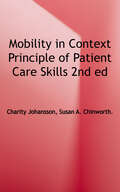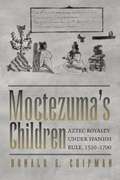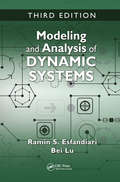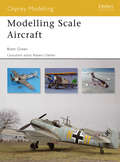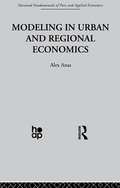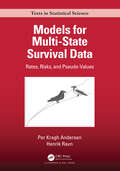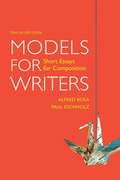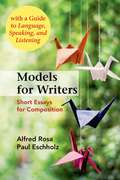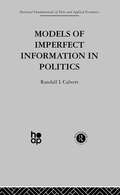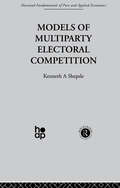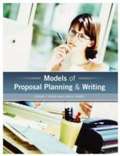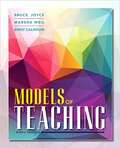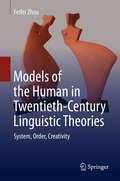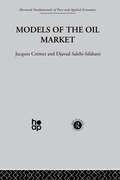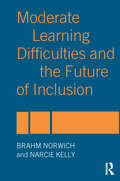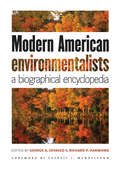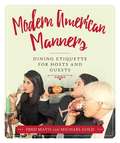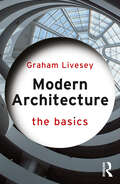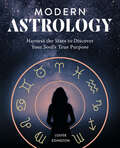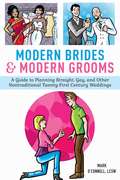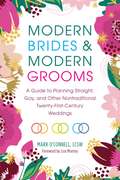- Table View
- List View
Mobile Security: How to Secure, Privatize, and Recover Your Devices
by Joseph Anderson Tim Speed Jaya Nampalli Mari Heiser Darla NykampLearn how to keep yourself safe online with easy- to- follow examples and real- life scenarios. Written by developers at IBM, this guide should be the only resource you need to keep your personal information private.Mobile security is one of the most talked about areas in I.T. today with data being stolen from smartphones and tablets around the world. Make sure you, and your family, are protected when they go online.
Mobility and Environment
by Corrado PoliMobility and Environment calls for a mobility revolution which does not simply mean taking a bus instead of a car: it implies a dramatic shift in the political debate from a technical to a political culture. The author introduces his book by disputing "non-political" Sustainable Development policies which are among the major culprits for the conservatism in environmental policies. For at least forty years, urban mobility policies, based on compulsive infrastructure building, have failed both in satisfying transportation demand and in coping with high environmental impacts. Nonetheless decision-makers keep employing the same professionals and therefore they act as shepherds who commit their sheep in the wolf's custody. Corrado Poli treats mobility policy as a political, ethical, social and educational issue rather than as a mere civil engineering one. Mobility and Environment challenges some deeply entrenched professional and economic monopolies which negatively affect urban and transportation planning in North America and Europe, and argues the old idea which bounded transportation and communication. A real environmentalist effort in traffic planning should begin from new technologies and from the analysis of citizens preferences. A series of new projects are presented which include mobility demand reduction and focus on democracy in planning.
Mobility in Context: Principles of Patient Care Skills
by Charity Johansson Susan A. ChinworthMaximize patient care skills Rely on this state-of-the-art, multimedia resource to help you navigate confidently in both common and complex clinical situations. Mastering patient care skills will ground you in fundamental rehabilitation principles; help you establish a culture of patient-centered care; and teach you to foster habits of clinical problem solving and critical thinking. You'll also learn how to help your patients progress toward greater mobility and independence. Over 750 full-color photographs and illustrations make every concept crystal clear. See the techniques in action Fifty-five full-color narrated video clips online at DavisPlus show you clinicians and patients performing key techniques described in the text.
Moctezuma's Children: Aztec Royalty under Spanish Rule, 1520-1700
by Donald E. ChipmanThough the Aztec Empire fell to Spain in 1521, three principal heirs of the last emperor, Moctezuma II, survived the conquest and were later acknowledged by the Spanish victors as reyes naturales (natural kings or monarchs) who possessed certain inalienable rights as Indian royalty. For their part, the descendants of Moctezuma II used Spanish law and customs to maintain and enhance their status throughout the colonial period, achieving titles of knighthood and nobility in Mexico and Spain. So respected were they that a Moctezuma descendant by marriage became Viceroy of New Spain (colonial Mexico's highest governmental office) in 1696.
Modeling and Analysis of Dynamic Systems
by Ramin S. Esfandiari Bei LuModeling and Analysis of Dynamic Systems, Third Edition introduces MATLAB®, Simulink®, and Simscape™ and then utilizes them to perform symbolic, graphical, numerical, and simulation tasks. Written for senior level courses/modules, the textbook meticulously covers techniques for modeling a variety of engineering systems, methods of response analysis, and introductions to mechanical vibration, and to basic control systems. These features combine to provide students with a thorough knowledge of the mathematical modeling and analysis of dynamic systems. The Third Edition now includes Case Studies, expanded coverage of system identification, and updates to the computational tools included.
Modelling Scale Aircraft
by Brett GreenBrett Green, one of the hobby's leading names, provides a comprehensive introduction to all of the basic techniques and materials needed to build scale aircraft, from first opening the kit box to displaying the finished model - all in one clear and easy-to-follow expert guide. The many detailed photographs with step-by-step captions, and the accessible and informative text cover every aspect of aircraft kit construction from initial preparation through all stages of assembly to detailed finishing. This is an essential resource for the novice aircraft modeller.
Modelling in Urban and Regional Economics (Fundamentals Of Pure And Applied Economics Ser. #Vol. 2)
by A. AnasThis title provides a comprehensive, critical coverage of the progress and development of mathematical modelling within urban and regional economics over four decades.
Models for Multi-State Survival Data: Rates, Risks, and Pseudo-Values (Chapman & Hall/CRC Texts in Statistical Science)
by Per Kragh Andersen Henrik RavnMulti-state models provide a statistical framework for studying longitudinal data on subjects when focus is on the occurrence of events that the subjects may experience over time. They find application particularly in biostatistics, medicine, and public health. The book includes mathematical detail which can be skipped by readers more interested in the practical examples. It is aimed at biostatisticians and at readers with an interest in the topic having a more applied background, such as epidemiology. This book builds on several courses the authors have taught on the subject. Key Features: · Intensity-based and marginal models. · Survival data, competing risks, illness-death models, recurrent events. · Includes a full chapter on pseudo-values. · Intuitive introductions and mathematical details. · Practical examples of event history data. · Exercises. Software code in R and SAS and the data used in the book can be found on the book’s webpage.
Models for Writers: Short Essays for Composition
by Paul Eschholz Alfred RosaIt’s a simple, best-selling combination that has worked for over 20 years — short, accessible essays and helpful, thorough writing instruction. Models for Writerscontinues to offer thought-provoking selections organized to demonstrate not only the rhetorical patterns that students will use in their own essays but also the elements and language that will make those essays effective.
Models for Writers: Short Essays for Composition (12th edition)
by Paul Eschholz Alfred RosaModels for Writers is designed to help you learn to write by providing you with a collection of model essays--that is, essays that are examples of good writing.
Models of Imperfect Information in Politics (Fundamentals Of Pure And Applied Economics Ser. #Vol. 6)
by R. CalvertSurveys the models of political phenomena that incorporate imperfect information, concentrating on 'full-rationality' approaches as opposed to bounded rationality models.
Models of Multiparty Electoral Competition (Fundamentals Of Pure And Applied Economics Ser.)
by K. ShepsleKenneth A. Shepsle surveys the formal literature on multiparty electoral competition.
Models of Proposal Planning and Writing
by Jeremy T. Miner Lynn E. MinerGrantseeking has become an increasingly competitive process. Beginning grantwriters sometimes assemble a collection of facts and present that information to grantmakers, hoping to receive support. However, sponsors rarely award grant funding just because a grantseeker supports a specific cause or works for a specific organization. Grantseekers must persuade sponsors to invest in their projects and organization. Successful grantseekers know that persuasion, not information, attracts funding. Persuasive proposals present a seamless argument that stands the test of reason, addresses psychological concerns, and connects project ideas to the values of the sponsor.
Models of Teaching
by Emily Calhoun Bruce R. Joyce Marsha WeilModels of Teaching: The Heart of the Core gives readers well-developed approaches to teaching, grounded in research and experience and designed to ensure the high levels of learning they are intended to generate. <p><p>With the goal of providing the strongest positive effect on student achievement while keeping in line with the current emphasis on standards-based education, Models of Teaching pairs rationale and research with real-world examples and applications to provide a strong foundation for future and new educators. The book encompasses all of the major psychological and philosophical approaches to teaching and schooling, includes thoroughly documented research on the various models of teaching and their subsequent positive effects on student success, and gives teachers the tools they need to build strong classrooms that accelerate student learning.
Models of the Human in Twentieth-Century Linguistic Theories: System, Order, Creativity
by Feifei ZhouThis book provides a refreshingly new perspective for investigating linguistic texts, which foregrounds models of the human. It presents a close reading of major linguistic theories in the twentieth century with a focus on three main themes: linguistic system and the individual speaker; social order; and linguistic creativity. The examination of these three fundamental themes concerning language and human nature, on the one hand, provides a fine-textured exposition on the implicit and explicit models of human nature endorsed by major theorists; on the other, it reveals the methodological dilemmas faced by linguistics. In light of the fact that the importance of considering posthumanist ideas is increasingly being underscored today, both within and outside linguistics, this focus on the human makes the book highly topical.
Models of the Oil Market
by J. Crémer D. Salehi-IsfahaniEconomists have proposed a large variety of models of the oil market and this survey integrates them in a coherent framework.
Moderate Learning Difficulties and the Future of Inclusion
by Brahm Norwich Narcie KellyChildren with mild to moderate learning difficulties (MLD) make up the largest sub-group of children requiring special educational needs, and yet they are often neglected in terms of research and in their influence on future Government policies. This book, based on a Nuffield Foundation research project, considers the perspectives of children with moderate learning difficulties, reviewing relevant issues such as:* identification of children with MLD;* appropriate curriculum and pedagogy;* inclusion in mainstream schools; * their identity and self-perception.The authors weave their findings into a wider review of current research in the MLD field and use a range of perspectives, from the professional, to psychological and sociological.This is a contemporary look at MLD that discusses the historical and policy context , origins and justification for having a category for MLD. Students, researchers, and academics that are active in the field of inclusive education will find this an insightful and comprehensive text.
Modern American Environmentalists: A Biographical Encyclopedia
by George A. Cevasco Richard P. HarmondModern American Environmentalists profiles the lives and contributions of nearly 140 major figures during the twentieth-century environmental movement. Included are iconic environmentalists such as Rachel Carson, E. O. Wilson, Gifford Pinchot, and Al Gore, and important but less expected names, including John Steinbeck and Allen Ginsberg. The entries recount how each individual became active in environmental conservation, detail his or her significant contributions, trace the influence of each on future efforts, and discuss the person's legacy. The individuals selected for the book displayed either an unparalleled commitment to the conservation, preservation, restoration, and enhancement of the natural environment or made a major contribution to the growth of environmentalism during its first century. With a foreword by environmental historian Everett I. Mendolsohn, a time line of key environmental events, a bibliography of groundbreaking works, and an index organized by specialization, this biographical encyclopedia is a handy and complete guide to the major people involved in the modern American environmental movement.
Modern American Manners: Dining Etiquette for Hosts and Guests
by Fred Mayo Michael GoldThis practical and humorous guide helps readers learn appropriate manners so they can enjoy the pleasures of good food, good drink, and good company without worrying about what behavior is proper. Chapters cover how to be a good host, how to be a good guest, and how to behave at business events, cocktail parties, formal dinners, and restaurants. There is also a unique chapter discussing pet peeves and how to handle them with grace, civility, and appropriate manners. What’s the proper way to hold a wine glass? What’s an appropriate gift to bring a host and what shouldn’t you bring? How should you correctly introduce guests to each other? If you’re the host, how do you determine who should sit next to whom? What should you do if you don’t want to drink alcohol at a cocktail party? What is appropriate cell phone usage at a business dinner? Here are easy-to-implement answers to these and many other important etiquette questions. Lavishly illustrated with memorable full-color photographs that highlight both good and bad table manners, Modern American Manners is full of friendly advice for business professionals, college students entering the workplace, and anyone needing a refresher course or an introduction to proper behavior.
Modern Architecture: The Basics (The Basics)
by Graham LiveseyModern Architecture: The Basics examines technological, stylistic, socio-political, and cultural changes that have transformed the history of architecture since the late 18th century. Broad definitions of modernity and postmodernity introduce the book, which comprises 24 short thematic chapters looking at the concepts behind the development of modern and postmodern architecture. These include major historical movements, key figures, and evolving building typologies. There is also an emphasis on the changing city during the 19th and 20th centuries. Approaches to representation and its impacts on architecture are studied, along with the changing global role of architecture as cultural expression. The book introduces new topics, including gender, race, postcolonialism, and indigeneity. An undaunting, contemporary, and inclusive account of modern architectural history, this is a must-read for all students of architecture as well as those outside the discipline approaching the subject for the first time.
Modern Astrology: Harness the Stars to Discover Your Soul's True Purpose
by Louise EdingtonModern Astrology offers a new, self-developmental approach to astrology with skills and strategies to take control of your life path and purpose. Astrology is a cosmic blueprint of who you are and what life holds, but it is not set it in stone. Leaving predictions to the past, Modern Astrology uses a contemporary psychological approach to decode your life's path and promote positive, personal growth through actionable skills and strategies. To unlock your potential, this astrology reader interprets the planets, signs, houses, aspects, and transits in your natal chart as keys to your life purpose. Armed with this self-awareness, Modern Astrology offers guided, developmental exercises and tactics to successfully navigate the trials and obstacles in alignment with your sign. Learn how astrology can be used as a functional tool to find meaning and happiness through self-knowledge, with: Astrology and psychology 101 that offers a basic understanding of astrology and its evolution into a field of self-help and psychology. Zodiac readings that provide in-depth explanation of the personality traits associated with every sign. Personal growth exercises that include soul-searching shamanic meditations, strategies to address obstacles associated with each sign, journaling prompts, and more! Astrology holds the answers to many of life's questions—but only you have the power to act on them. In Modern Astrology, you'll discover who you are, what you want, and what you need to do in order to be the best version of yourself.
Modern Brides & Modern Grooms
by Liza Monroy Mark O'ConnellHow to make any wedding liberating, brave, and sexy.This post-DOMA book is for any couple-same or opposite sex-seeking a personalized wedding that dignifies the relationship and the individual self. No "new normal" here-this guide emboldens you to harness your unique, brazen, queer truth; to be creative; and to plan your wedding your way.Every fiancé faces the question: How do I become something new without losing myself? Using his own story-from how he and his husband connected via MTV's The Real World to the real world of their marriage-author Mark O'Connell reflects on conflicts that arrive during wedding transitions, as well as various other transitions throughout your lives.As a psychotherapist, O'Connell offers ideas to bridge relational gaps with your partner, family, and friends. As a professional actor, he also offers insight into the ways your wedding is a theatrical production: how this can help you to conceptualize the event, consolidate your efforts, and increase creative collaboration as a couple. This will serve you not only on the day, but also for the rest of your time together.Whether we're straight, gay, or other, weddings inspire us to carve out more fun, freedom, recognition, life-space, love-space, and connubial space than we've ever had before.
Modern Brides & Modern Grooms: A Guide to Planning Straight, Gay, and Other Nontraditional Twenty-First-Century Weddings
by Liza Monroy Lcsw Mark O'ConnellThis book is for any couple-same or opposite sex-seeking a personalized wedding that dignifies the relationship and the individual self. No "new normal" here-this guide emboldens you to harness your unique, brazen, queer truth; to be creative; and to plan your wedding your way.Every fiancé faces the question, how do I become something new without losing myself? Using his own story, author Mark O'Connell reflects on conflicts that arrive during wedding transitions, as well as various other transitions throughout your lives.As a psychotherapist, O'Connell offers ideas to bridge relational gaps with your partner, family, and friends. As a professional actor, he also offers insight into the ways your wedding is a theatrical production and how this can help you to conceptualize the event, consolidate your efforts, and increase creative collaboration as a couple. This will serve you not only on your big day, but also for the rest of your time together.Whether we're straight, gay, or other, weddings inspire us to carve out more fun, freedom, recognition, life space, love space, and connubial space than we've ever had before.
Modern Buildings in Britain: A Gazetteer
by Owen HatherleyThe definitive illustrated guide to modern British architecture, from one of the most acclaimed critics at work todayModernism is now a century old, and its consequences are all around us, built into our everyday lived environments. Its place in Britain's history is fiercely contested, and its role in our future is the subject of ongoing controversy - but modernist buildings have undoubtedly changed our cities, politics and identity forever.In Modern Buildings in Britain, Owen Hatherley applauds the ambition and explores the significance of this most divisive of architectures, travelling from Aberystwyth to Aberdeen, from St Ives to Shetland, in search of our most important and distinctive modern buildings. Drawing on hundreds of examples, we learn how the concrete of Brutalism embodies post-war civic principles, how corporate values were expressed in the glass façades of the International Style, and why Ecomodernist experimentation is often consigned to the geographic fringes. As Hatherley considers the social, political and cultural value of these structures - a number of which are threatened by demolition - two linked questions emerge: what happens to a building after it has been lived in, and what becomes of an idea when its time has passed?With more than six hundred pages of trenchantly opinionated, often witty analysis, and with three hundred photographs in duotone and colour, Modern Buildings in Britain is a landmark contribution to the history of British architecture.
Modern Buildings in London
by Ian Nairn&“Without any doubt, London is one of the best cities in the world for modern architecture. But it is also one of the biggest cities in the world, and it does not make a display of its best things. A visitor looking for new buildings in the City and the West End might well be justified in turning away with a shudder. Yet delightful things may be waiting for him in Lewisham or St. Albans.&” —Ian Nairn, from the forewordAs one of the few architectural critics to eschew purely aesthetic modes of analysis, Ian Nairn&’s timeless books on modern urban cities have been hailed as some of the most significant writing about contemporary Britain, while also being praised as alternative &“guidebooks&” for curious travellers. First published in 1964, Modern Buildings in London celebrates the character of buildings that were immediately recognisable as &“modern&” in 1964, many of which were not the part of the well-known landscape of London but instead were gems that Nairn stumbled across.Written &“by a layman for laymen,&” Nairn&’s take on modern design includes classic buildings such as the Barbican, the former BBC Television Centre and the Penguin Pool at Regent&’s Park Zoo as well as schools, old timber yards, ambulance stations, car parks and even care homes.


